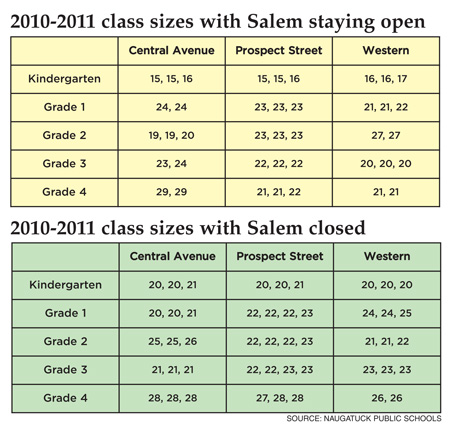NAUGATUCK — Even though enrollment in the borough’s public school system is at a low ebb—it has dwindled by about 15 percent since 2001—the closure of Salem school, which has been put on hold for now (see story here), would necessitate larger class sizes at Central Avenue, Prospect Street and Western schools, where Salem students would be transferred.
According to information presented last Thursday at the Board of Education’s public hearing on its 2010-11 budget proposal, classes at those schools, if Salem were to close, would need to accommodate as many as 21, 25, 26, 23 and 28 students in grades K-4, respectively. The average class size for all five remaining elementary schools would be 22.28 students.
Middle school class sizes at a consolidated facility in the City Hill building, Superintendent Dr. John Tindall-Gibson said, will be “pushing 30.”
Many who commented at the hearing worried not only about the potential educational impact of larger class sizes but also about what the future could hold for a packed school system, if and when enrollment increases significantly.
“I would argue that closing any elementary school in Naugatuck at this point is foolish,” said Jay Carlson, chairman of the Naugatuck Economic Development Corp. “It wasn’t that long ago, seven or eight years ago, that we were discussing the building of other schools in town … what we’re doing right now is a bit of a knee-jerk reaction to a short-term problem. … As sure as I’m standing here right now, in two years, five years, maybe, somebody’s going to be standing up here saying ‘We need a new school. We don’t have enough schools here in town.’”
Glenn Connan, who is a member of the Citizen’s Audit Committee, said, “If we’re going to save $400,000 [by closing Salem] and then three years from now be told we have to build a new school and come up with all this money to go out to bond, I’m not going to want to hear that.”
A report prepared by JCJ Architecture, which the school district hired to study its facilities usage, projects district-wide enrollment won’t change drastically through 2015. It predicts an enrollment of 4,675 students, which would be a decrease from the current 4,767. But according to the study, enrollment will only remain fairly level because as “high school enrollment continue[s] to decline” enrollment in borough elementary schools will “increase by the same amount.”
Tindall-Gibson, who announced last week he would retire in 2012, conceded that enrollment is not an easy thing to predict.
“At this time, we believe we have adequate space to accommodate any minor increase in enrollment,” he said. “In terms of what that’s going to look like five years down the road, I’m not too certain.”
Mezzo said Monday that Naugatuck would almost certainly need a new elementary school within the next decade anyway, “not based on simple population but just based on buildings. … I mean building equity. We’ve got very small elementary schools that are quite old in many cases. I will support publicly, on the record, that within the next 10 years, Naugatuck is going to need another elementary school.”
Naugatuck Teacher’s League Vice President and Spokesman Charley Marenghi implored the board to “hold the line” on further staff cuts to keep class sizes from increasing even more.
“There’s no way we can deliver the level of instruction the children of Naugatuck deserve, if we have any further cuts in staffing,” he said. “If it means we have to cut the [$60,000] textbook line, cut it. If it means we have to cut the money that’s set aside for professional development and other options, then by all means do so.”














